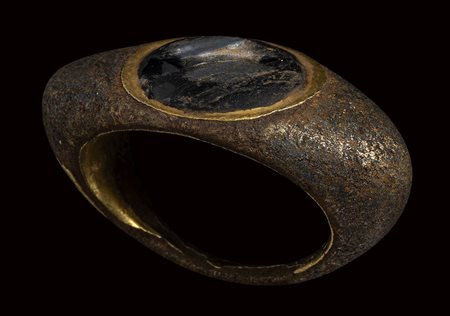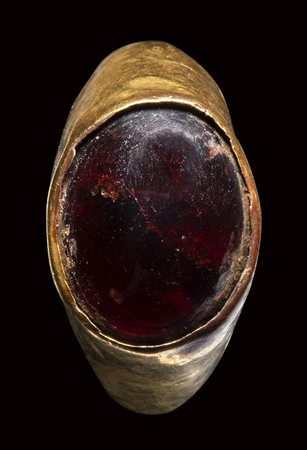Auction 86 - Glyptics and Ancient Jewelry
-

Lot 241 A large late roman gilted bronze ring set with a glass paste.
1st century B.C.
Glass : 13 x 15 mm
ring : 21 x 16 mm
17,36 g
Oval hoop, convex without, concave within. It broadens out widely at the head. The bezel is in the form of a raised gold hollow disk soldered to the head of the ring, with a glass.
Parallel: Antiken Gemmen in Deutschen Sammlungen, Band. IV, T.36, n°236, inv. K 1349
U.K private collection -

Lot 242 A graeco-roman gold ring set with a garnet cabochon.
2nd B.C. - 2nd century A.D.
Stone : 9 x 12 mm
Ring : 15,5 x 15 mm
3,29 g
Hollow hoop rounded with large ending and oval bezel set with a nice oval cabochon garnet.
Parallel: Marshall, F.H., Finger rings, 1968, p. 121, n°725
U.K private collection, London. -

Lot 243 A roman burnt agate cameo mounted in a gold ring. Mythological scene.
3rd century A.D.
Cameo : 10 x 12 mm
ring diam : 21 x 19 mm
5,48 g
The surface of the cameo is partially damaged by the ancient burns, which partly "baked" the stone. Scene to identify. The cameo is mounted in an ancient ring decorated with four spheres between the bezel and the smooth annular rod. Wear marks.
U.K private collection, London. -

Lot 244 A lot of three roman gold finger rings.
2nd – 3rd century A.D.
Diam : 13,5 mm / 11 mm / 14 mm
7,64 g
From left to right ;
- Hoop composed of a serie of gold spheres ending with two laterals ones and a almond-shapes bezel set with a garnet.
- A gold plain hoop rounded within and without, the bezel marked by two vertical engraved lines.
- Hoop rounded within and without, enlarged at the ends with a circular engraved bezel.
U.K private collection -

Lot 245 A roman gold engraved child ring. Dextrarum Junctio.
3rd – 4th century A.D.
Diam : 13 x 11 mm
3,29 g
Flat hoop, broad and polygonal. Long bezel with engravd design representing two hands clasping.
Parallel: Marshall, F.H., 1968, Catalogue of finger rings, p. 189, n° 1199
U.K private collection -

Lot 246 A roman pair of gold earring with garnets.
1st century B.C. - 1st century A.D.
H : 22 mm
3,02 g
Pair of crescent-shape earrings, each hoop composed with two rows of spherical elements ending with a gold ovoid setting with a cabochon garnet.
Little damages on some spherical beads.
Parallel: Metropolitan Museum of Art, NY, inv. 1995.85.3-7.
U.K private collection -

Lot 247 A roman pair of gold earring with discs and pendants.
2nd century A.D.
H : 32 mm circa
4,24 g
Hoop with discoid plaque, loop beneath with breloque and granule, ending in spirals.
U.K private collection -

Lot 248 A roman gold and garnet earring with disc and pendant.
2nd century A.D.
H : 28 mm
2,43 g
Hoop with discoid plaque and granule above. The disc set with a garnet cabochon, loop beneath with breloque fromed as a loop and granulated lobes. Wire beneath.
Small crack on the garnet.
U.K private collection -

Lot 249 A pair of roman gold earrings set with garnets.
2nd - 3rd century A.D.
H: 39 mm ; 5,32 gr.
Each earring set with garnet cabochon (one damaged) in a gold disc box decorated with twisted gold wires. Supension rings intertwined with a gold twisted pendeloque and granulation. At the terminals, suspension hoops and hooks.
Monte-Carlo private collection, Mr. P.L, 1982 -

Lot 250 A gold and coral roman apotropaic phallic pendant.
1st century B.C. – 1st century A.D.
21 x 37 mm
5,59 g
The coral sculpted phallus, naturalistically modeled is set in a clip made with soldered gold plaques ending with a large hoop.
This pendant was worn as an apotropaic amulet.
U.K private collection, London. -

Lot 251 A romano-egyptian gold amulet. Aphrodite
1st - 2nd century A.D.
H : 40 mm
3,45 g
Composing with two embossed layers of gold, this hollow figure represents the goddess with a naked bust, the lower part of the body covered by a folded drapery. She standing on a rounded base.
Her arms, touching her hair, she wears bracelets.
Suspension loop on her back. This figure was worn as a pendant.
Parallel: Marshall, F.H., Catalogue of Jewellery, p. 360, n° 3011, 3012
U.K private collection, London. -

Lot 252
A roman gold necklace with a moon crescent pendant (lunula).
1st century A.D.
L: 255 mm
5,05 g
Gold necklace composed of a chain of plated wire ending in a hook-shaped clasp. The crescent pendant is attached to the chain with a solid gold loop. Very fine condition.
Parallels :
Marshall, F.H., Jewellery, p.314, n° 2720
U.K private collection -

Lot 253 A roman gold bracelet.
1st century A.D.
L : 200 mm
9,90 g
Consisting of a band of six plated strands ending in a clasp with cylindrical form.
Exceptional state of conservation. This model is inspired by the classical greek jewellery.
Parallel: Marshall, F.H., Jewellery, p.314, n°2719
U.K private collection -

Lot 254 A late roman large gold brooch set with an agate, garnets and emeralds
4th - 5th century A.D.
33 x 44 mm
15,49 g
The structure of the jewel is in oval-shape, with a hollow and slightly convex body. In the center there is a three-layered agate (which has fallen into the brooch over time and moves slightly in the frame). Around it, five oval garnets and five oval/rectangular emeralds. The brooch is characterized by a finely chiseled frame. The back of the brooch is characterized by a heart-shaped relief ornament. The large-sized jewel is in good general condition, with patina and sediment deposits. Slight damage. Intact.
U.K private collection, London. -

Lot 255 A roman rock crystal amphoriskos.
1st century B.C.
H_ 54 mm
Diam max : 39 mm
With a piriform-shape, short neck and a rounded rim. The shoulders with twin pierced lug handle. The belly with 7 relief discs. Probably an unguentarium. Cracking and wear marks. Patina deposit. Very rare specimen.
U.K. private collection 1985. Formerly in Arthur Sambon (1867-1947) collection. -

Lot 256 Two fragments of roman murrina vasa.
1st century B.C. - 2nd century A.D.
22 x 28 mm
18 x 22 mm
The two fragments of cupped vase come from two different artefacts carved in two different beautiful sardonyx varieties.
A fragment has a smooth mirror-polished surface, convex and of fairly uniform thickness, with the presence of typical nodules. The other piece has a cameo carved surface, of uneven thickness and probably decorated with figures. Two precious examples of disappeared artifacts, already from the time of the Romans considered particularly precious and of great luxury. Rare.
Parallel: D. Del Bufalo, Murrina Vasa. A luxury of imperial Rome, 2016.
U.K. private collection -

Lot 257 A large eastern roman carnelian intaglio. Bearded male bust with astrological symbols.
1st - 3rd century A.D.
24 x 29 x 12 mm
The character faces left and is characterized by a thick beard, finely engraved hair with a laurel wreath. The bust ends in front with a scorpion, and behind with a crab, both zodiac symbols. The large stone is characterized by small deposits and traces of iron even inside the carving. Probably a middle-eastern workshop. Very rare astrological iconography.
U.K private collection, London. -

Lot 258 A sasanian green jasper stamp-seal. Lion and inscriptions.
5th century A.D.
12 x 14 x 11 mm
Ellipsoid shaped stamp-seal with high domed back and hole lenghtwise. On the flat base, a lion running on the left, the head in front. On top, pahlavi inscription "'ys'gzy(?)" For a similar example : MET, NY, inv.81.6.288
Chips on the edge.
Parallel: Brunner, Christoph, Sasanian Stamp Seals in the Metropolitan Museum of Art, p.96
U.K private collection -

Lot 259 A large early medieval agate intaglio. Medusa mask.
12th-13th century
24 x 26 x 5 mm
The thick stone is engraved with a Medusa mask characterized by a rounded face with plain chicks, full lips, and a straight little nose. The eyes are framed by heavy lids and the pupils are marked by a globular element. The forehead is surmonted by some curly short locks and snakes surrounding the face until the chin. This unusual stone is characterized by certain stylistic, iconographic and executive details that place it in the glyptic production referable to the court of Frederick II Hohenstaufen. The cameo production is better known, while the intaglio production is still little known and rare. The frontal face of this Medusa certainly emulates the classical models of the Greek-Roman Era, but reveals its evolution through the models of late antiquity with new stylistic features belonging to the early medieval age. The shape, the choice of this variety of agate (slight burnt on the back side) and the type of polishing seem to confirm this dating and the geographical area of its production (southern italian ateliers). The choice of a mythological subject inspired by classical antiquity is in line with the Federician cultural project, always maintaining its apotropaic meaning. The stone was mounted probably in a pendant.
Parallels for the glyptics production of the Federican Court: Aa.Vv. La Glittica Santarelli ai Musei Capitolini, pp. 215 ss with references to Antonio Giuliano researches.
European private collection 80's -

Lot 260 A postclassical agate intaglio. Seated male figure with a globe.
18th - 19th century
10 x 13 x 3 mm
The character is seated on a rock and rests his left foot on a base on the ground; with his left hand he raises a globe. Groundline. Wear marks. Postclassical work. -

Lot 261 A postclassical crysoprase intaglio. Asclepius.
18th-19th century
10 x 12 x 2,5 mm
The naked deity is seated on the rocks, holding a cup and the scepter with entertwined snake. Groundline. Attractive color of the stone. Postclassical work. -

Lot 262 A post classical agate intaglio. Sacrifice scene.
17th - 18th century
13 x 16 x 3 mm
An old male character with a cloak is in the act of making a sacrifice over a small altar. With both hands he holds offerings. Groundline. Attractive variety of stone. Wear marks. Light chipping on the edge. Postclassical work. -

Lot 263 A postclassical agate intaglio. Gryllos.
18th - 19th century
14 x 16 x 4 mm
The hybrid creature is composed by: mask of an elder Silenus conjoined with a young draped bust; two others male masks are conjoined to the apotropaic depiction. The stone, characterized by a slightly burnt surface, is broken and recomposed in the upper part, and has a crack at the bottom. Wear marks. Postclassical work. -

Lot 264 A postclassical agate-nicolo intaglio. Hades.
18th - 19th century
15 x 18 x 3 mm
The ruler of the Inferos is seated on the throne, facing left, in the act of pouring a drink and quenching a crow's thirst on a column ending in a globe. A trident is leaning against the throne. Behind, the inscription INAP. Groundline. Wear marks.
